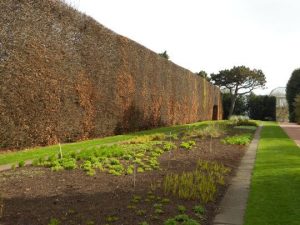Hedges are integral to the design and ecology of the garden. Forget the quick fix provided by larchlap panels, take time to make a choice of the many species that will give privacy, act as a windbreak, divide areas and provide a home to insects, birds and shelter to many mammals. A hedge is indeed greater than the sum of its parts, and adds to the biodiversity of the area. Hedges are structures that benefit from initial soil preparation, remember these are planted by you and have the potential to be in place a century later. Double dig the stretch of ground incorporating, ideally, well-rotted farm yard manure into the bottom of the trench. The roots will soon draw down into this zone and your investment in this preparation will soon show in extension growth. A favoured species to plant as a hedge; Beech, Fagus sylvatica. One proviso, choose seedlings that are collected from a tree of low elevation provenance. The Beech hedge in the Garden here has a leaf unfurling date around mid-April. There are seasonal variations depending on the weather, 10th April being the earliest and 28th the latest. Keep your eyes open as you travel about Edinburgh and compare when other Beech hedges leaf out. There is a 6 week variation between earliest and latest date. Choose wisely, ask the nurseryman. The longer growing season from an early flushing plant will result in a better formed hedge sooner than later. At the end of the first growing season when dormancy has set in and outwith a spell of heavy frost, with secateurs, lightly cut back the previous season’s growth to form the shape of the hedge. If the hedge is at the back of a border the young plants are easily swamped by competing vegetation. Through the summer make sure this does not occlude light from the base of the hedge. The lower shoots when young are susceptible to die back when swamped with competing foliage. If this happens there will be an open bare base to the hedge. Not a desirable look. It will take three growing seasons for the individual plants form a hedge that provides a worthwhile screen and depth of cover to attract nesting birds. From the first season there will be habitat benefit, raising the ecological stakes in your garden.

Beech hedge into growth
